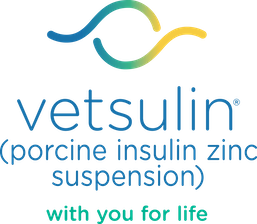

Related Diseases
Read More About Canine Diagnosis & Management
Diseases That May Complicate the Treatment of Diabetes
Acromegaly
Acromegaly is a rare endocrine disease caused by growth hormone excess. It is characterized by chronic overgrowth of connective tissue, bone, and viscera. Among other clinical signs, insulin resistant diabetes and enlargement of soft tissue organs and proliferation of gum tissue is seen. Acromegaly occurs more frequently in cats with diabetes than in dogs.
Acromegaly in dogs occurs most commonly in older, intact female dogs resulting from progesterone stimulation of growth hormone. This growth hormone may be produced in mammary tissue. Acromegaly may rarely be caused by pituitary or hypothalamic neoplasia. Spaying of bitches is usually curative, although the concurrent diabetes may be permanent, depending on the remaining ability of the pancreas to secrete insulin.
Exocrine Pancreatic Insufficiency (EPI)
Exocrine pancreatic insufficiency is a congenital or acquired condition that can affect both dogs and cats, although it is more common in dogs. Young adult dogs, especially German Shepherds, are usually affected. In dogs, EPI is usually due to pancreatic acinar atrophy (PAA). It may be seen together with diabetes mellitus if there is damage to both the exocrine and endocrine pancreas.
Pathophysiology
- Digestive enzymes are not secreted normally by the pancreas.
- Food is not sufficiently digested and processed.
- Diarrhea and weight loss occur in spite of a normal or increased appetite.
Diagnosis and Treatment
EPI is diagnosed based on blood tests and is treated with pancreatic enzyme replacements. Enzyme replacements usually result in improvement of the clinical signs, and dietary management. However, if due to chronic pancreatitis and accompanied by diabetes mellitus, it can be more difficult to treat successfully.
Hyperadrenocorticism (Cushing’s disease)
Hyperadrenocorticism is a relatively common endocrine disease of dogs.
Etiology
- Excessive endogenous cortisol production
- Pituitary tumor (85% of cases) producing excessive adrenocorticotrophic hormone (ACTH)
- Adrenal tumor (15% of cases) producing excessive cortisol
- Iatrogenic administration of exogenous glucocorticoids (iatrogenic hyperadrenocorticism).
Clinical signs
Hyperadrenocorticism is a slowly progressive disease with signs that vary in severity depending on the duration and degree of cortisol excess. Clinical signs are similar to diabetes mellitus:
- Polyuria
- Polydipsia
- Polyphagia
In addition, dogs frequently have a pot-bellied appearance and alopecia or other skin and/or coat changes. Diabetes mellitus may develop secondary to hyperadrenocorticism, due to insulin resistance caused by cortisol excess.
Treatment:
Hyperadrenocorticism can be treated medically or surgically. Concurrent diabetes mellitus requires insulin treatment. Dogs with both diseases may require higher than expected insulin doses, particularly if the hyperadrenocorticism is not controlled.
Pancreatitis
Pancreatitis is inflammation of the pancreas. Digestive enzymes leak into and damage the surrounding pancreatic tissues.
Etiology
In most cases, the cause of pancreatitis is idiopathic. Other predisposing factors may be:
- High-fat, low-protein diet
- Dietary indiscretion
- Other diseases (Cushing’s syndrome, diabetes mellitus)
Risk factors for pancreatitis include:
- Breed—Miniature Schnauzer, Miniature Poodle, and Cocker Spaniel are at higher risk
- Obesity
- Diabetes mellitus
- Cushing’s disease
- Chronic renal failure
Acute pancreatitis may produce temporary diabetes mellitus and if there is extensive pancreatic necrosis, this may become permanent. A similar situation can arise if there is pancreatic neoplasia.
Help Your Practice Manage Diabetes Mellitus
View and download resources and tools that will assist your hospital, inform your team, and help with clients.

Blood Glucose Curve Generator
Create a blood glucose curve to monitor and evaluate diabetes treatments.

Client Discharge Form
Create a customized, printable form for clients about their new diagnosis.

Diabetes Resources
Access online tools and more to support staff and pet parents.
No items to show.
Read More About Canine Diagnosis & Management
Important Safety Information:
Vetsulin® should not be used in dogs known to have a systemic allergy to pork or pork products. Vetsulin is contraindicated during periods of hypoglycemia. Keep out of reach of children. As with all insulin products, careful patient monitoring for hypoglycemia and hyperglycemia is essential to attain and maintain adequate glycemic control and prevent associated complications. Overdosage can result in profound hypoglycemia and death. The safety and effectiveness of Vetsulin in puppies, breeding, pregnant, and lactating dogs has not been evaluated. See package insert for full information regarding contraindications, warnings, and precautions.
References:
1. Martin GJ, Rand JS. Pharmacology of a 40 IU/ml porcine lente insulin preparation in diabetic cats: findings during the first week and after 5 or 9 weeks of therapy. J Feline Med Surg. 2001;3(1):23–30. 2. Vetsulin® (porcine insulin zinc suspension) [Freedom of Information Summary]. Millsboro, DE: Intervet Inc.; 2008. 3. Data on file, Merck Animal Health. 4. Graham PA, Nash AS, McKellar QA. Pharmacokinetics of porcine insulin zinc suspension in diabetic dogs. J Small Anim Pract. 1997;38(10):434–438. 5. Martin GJ, Rand JS. Pharmacokinetic and Pharmacodynamic Study of Caninsulin in Cats with Diabetes Mellitus. 2000: Internal Study Report. 6. Feldman EC, Nelson RW. Canine and Feline Endocrinology and Reproduction. 3rd ed. St. Louis, MO: Saunders; 2004:539–579. 7. Tennant B, ed. BSAVA Small Animal Formulary. 4th ed. Gloucestershire, UK: British Small Animal Veterinary Association; 2002. 8. Feldman EC, Nelson RW. Canine and Feline Endocrinology and Reproduction. 3rd ed. St. Louis, MO: Saunders; 2004:486–538. 9. Reusch C. Feline diabetes mellitus. In: Ettinger SJ, Feldman EC, eds. Textbook of Veterinary Internal Medicine. 7th ed. St. Louis, MO: Saunders; 2010:1796–1816. 10. Nelson RW. Canine diabetes mellitus. In: Ettinger SJ, Feldman EC, eds. Textbook of Veterinary Internal Medicine. 7th ed. St. Louis, MO: Saunders; 2010:1782–1796. 11. Burgaud S, Riant S, Piau N. Comparative laboratory evaluation of dose delivery using a veterinary insulin pen. In: Proceedings of the WSAVA/FECAVA/BSAVA congress; 12–15 April 2012; Birmingham, UK. Abstract 121. 12. Burgaud S, Guillot R, Harnois-Milon G. Clinical evaluation of a veterinary insulin pen in diabetic dogs. In: Proceedings of the WSAVA/ FECAVA/BSAVA congress; 12–15 April 2012; Birmingham, UK. Abstract 122. 13. Burgaud S, Guillot R, Harnois-Milon G. Clinical evaluation of a veterinary insulin pen in diabetic cats. In: Proceedings of the WSAVA/FECAVA/BSAVA congress; 12–15 April 2012; Birmingham, UK. Abstract 45. 14. Davison LJ, Walding B, Herrtage ME, Catchpole B. Anti-insulin antibodies in diabetic dogs before and after treatment with different insulin preparations. J Vet Intern Med. 2008;22:1317-1325. 15. Banfield State of Pet Health 2016 Report. p 12-13.
